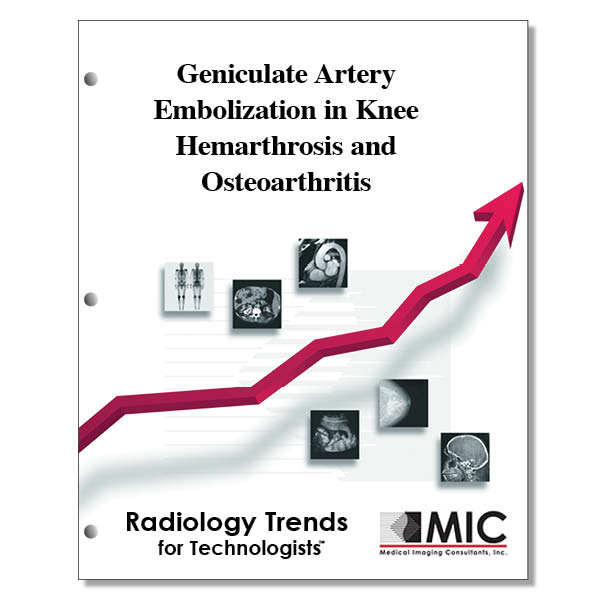

Geniculate Artery Embolization in Knee Hemarthrosis and Osteoarthritis
A review of the clinical and radiologic findings of recurrent hemarthrosis and osteoarthritis of the knee, as well as the minimally invasive treatment option of geniculate artery embolization.
Course ID: Q00707 Category: Radiology Trends for Technologists Modalities: MRI, Radiography, Vascular Interventional2.00 |
Satisfaction Guarantee |
$24.00
- Targeted CE
- Outline
- Objectives
Targeted CE per ARRT’s Discipline, Category, and Subcategory classification:
[Note: Discipline-specific Targeted CE credits may be less than the total Category A credits approved for this course.]
Computed Tomography: 0.50
Procedures: 0.50
Head, Spine, and Musculoskeletal: 0.50
Magnetic Resonance Imaging: 1.50
Procedures: 1.50
Musculoskeletal: 1.50
Radiography: 0.50
Procedures: 0.50
Extremity Procedures: 0.50
Registered Radiologist Assistant: 2.00
Procedures: 2.00
Musculoskeletal and Endocrine Sections: 1.50
Neurological, Vascular, and Lymphatic Sections: 0.50
Sonography: 0.50
Procedures: 0.50
Superficial Structures and Other Sonographic Procedures: 0.50
Vascular-Interventional Radiography: 1.50
Procedures: 1.50
Vascular Interventional Procedures: 1.50
Outline
- Introduction
- Hemarthrosis
- Pathophysiology
- Clinical Manifestations and Diagnosis
- Treatment
- Osteoarthritis
- Pathophysiology
- Clinical Manifestations and Diagnosis
- Treatment
- Geniculate Artery Embolization
- Anatomy
- Procedure and Technical Details
- Embolic Agents for GAE
- GAE in Hemarthrosis
- GAE in Osteoarthritis
- Complications
- Conclusion
Objectives
Upon completion of this course, students will:
- recognize the prevalence of Americans over 60 with chronic pain due to knee OA
- identify the outcomes or results for those suffering with knee OA
- identify the durability of response for patients undergoing GAE of the knee
- recognize the clinical manifestations of knee hemarthrosis
- identify the initial preferred imaging modality when hemarthrosis is suspected
- identify the imaging modality which shows chronic sequelae of intra-articular hemorrhage, including cartilage and meniscal destruction.
- recognize the reference standard technique to confirm hemarthrosis
- understand the outcomes of using conservative treatment for hemarthrosis
- recognize the factors fueling inflammatory drive and degenerative osteoarthritic changes in patients with knee OA
- be familiar with the KL classification system for OA
- be familiar with conservative treatments for patients with knee OA
- be familiar with the burden of disease in patients with knee OA
- identify the genicular arteries that are targets when performing GAE
- recognize the genicular arteries providing vascularization of the patella and patellar tendon
- be familiar with palpating the general target area prior to catheterization
- identify the size of the microcatheter for GAE for knee OA
- recognize the vasculature of the knee
- be familiar with techniques used to better characterize the anatomy during GAE
- identify the general embolic classification for GAE
- identify the non-filling of the lateral genicular branches and loss of synovial blush on imaging
- be familiar with the drug IPM-CS
- be familiar with the KL grade findings for the patients studied
- be familiar with the use of Embospheres in patients studied
- be familiar with the percentage of patients experiencing hematomas during GAE studies
- identify the particle sizes for IPM-CS used in GAE for knee OA
- be familiar with the clinical success of those patients studied after TKA
- be familiar with the technical success of those studied receiving GAE for knee OA
- be familiar with the total clinical success reported after recurrent GAE for the patients studied
- identify the total complication rate for patients undergoing GAE for knee OA
- recognize the clinical assessment tools to evaluate GAE for treatment of OA
- be familiar with KOOS classification ratings
- identify the patient group based on KL ratings for which GAE may not be optimal
- recognize the potential positive outcomes for performing GAE for knee OA
- identify the most common complication after performing GAE for knee OA
- be familiar with the effect embolic particle size has on preventing transient cutaneous complication in GAE
